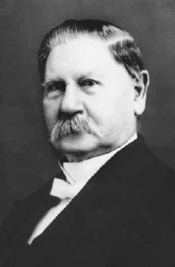Name Charles Penrose Called by Heber J. Grant | Called by Joseph F. Smith | |
 | ||
Books "Mormon" Doctrine - Plain and, Why I Am a "Mormon", Poems by Charles Penrose, Rays of Living Light | ||
Charles William Penrose (4 February 1832 – 16 May 1925) was a member of the Quorum of the Twelve Apostles of The Church of Jesus Christ of Latter-day Saints (LDS Church) from 1904 to 1911. Penrose was also a member of the First Presidency of the church under church presidents Joseph F. Smith and Heber J. Grant from 1911 until his death.
Contents
Penrose was born in London, England. It is said that he learned to read the Bible by the age of four. Penrose was introduced to the LDS Church and baptized at the age of eighteen on 14 May 1850, in London. He also met and married his wife Lucetta Stratford in London. The couple had 15 children.
After joining the LDS Church, Penrose was called to a seven-year mission, preaching throughout England. In 1861, he emigrated to Utah Territory. After arriving in the Salt Lake Valley, he was asked to return to England as a missionary. Upon his return, he settled in Ogden, Utah, where he became involved in newspaper publishing. Eventually, Penrose became the editor of the LDS Church-owned Deseret News in Salt Lake City. Penrose was known for his writing, including missionary tracts and lyrics of Mormon hymns, including "God of Our Fathers", "O Ye Mountains High", and "Up, Awake, Ye Defenders of Zion".
Penrose served in the Utah Territorial Legislature. In 1880, he introduced a bill, largely at the urging of Emmeline B. Wells, that would have allowed women to serve in all public offices in the territory.
Some have claimed that Penrose was the chief author of the 1890 Manifesto. However, George Reynolds testified in the Smoot Hearings before the U.S. Senate that he, Penrose, and John R. Winder only edited and prepared for publication the text that church president Wilford Woodruff had written.
Penrose was a professor of theology at Brigham Young Academy from 1897 to 1899 and again in 1901 and 1902.
Penrose was called to the Quorum of the Twelve Apostles and ordained an apostle on 7 July 1904. He was called to fill a vacancy in the quorum caused by the death of Abraham O. Woodruff. On 7 December 1911, Penrose became Second Counselor to Joseph F. Smith in the Presidency of the Church; he replaced John Henry Smith, who died. James E. Talmage filled the vacancy in the Quorum of the Twelve caused by Penrose's elevation to the First Presidency. After Joseph F. Smith's death in 1918, Penrose was retained as Second Counselor by new church president Heber J. Grant. On 10 March 1921, Penrose became First Counselor in the First Presidency; he succeeded Anthon H. Lund, who had died eight days earlier.
Death
Penrose served in the First Presidency until his death in Salt Lake City from chronic prostatitis. He was buried at Salt Lake City Cemetery.
Hymns
Some of Penrose poems were put to music and became LDS Church hymns. Penrose's "Up, Awake, Ye Defenders of Zion"—originally a militant hymn containing references to trials of Latter-day Saints in the central United States and the threatening United States government (ironically set to the melody for "Columbia, Gem of the Ocean")—became an anthem for Latter-day Saints during the difficulties preceding and during the Utah War of 1857–58.
Some of Penrose's lyrics appear in the current LDS hymnal, including:
